
Aspinwall is a borough on the Allegheny River in Allegheny County, Pennsylvania, United States. It is part of the Pittsburgh metropolitan area. The population was 2,916 at the 2020 census.

Sharpsburg is a borough in Allegheny County, Pennsylvania, United States, 5 miles (8 km) northeast of downtown Pittsburgh, along the Allegheny River. In 1900, nearly 7,000 people lived here; in 1920, the population peaked at just over 8,900 people. The population was 3,187 at the 2020 census.
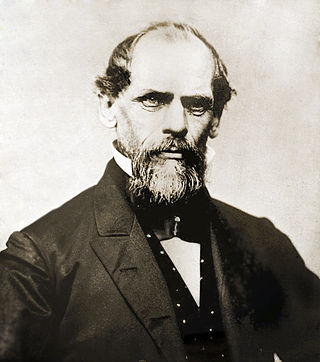
John Augustus Roebling was a German-born American civil engineer. He designed and built wire rope suspension bridges, in particular the Brooklyn Bridge, which has been designated as a National Historic Landmark and a National Historic Civil Engineering Landmark.

A truss bridge is a bridge whose load-bearing superstructure is composed of a truss, a structure of connected elements, usually forming triangular units. The connected elements, typically straight, may be stressed from tension, compression, or sometimes both in response to dynamic loads. There are several types of truss bridges, including some with simple designs that were among the first bridges designed in the 19th and early 20th centuries. A truss bridge is economical to construct primarily because it uses materials efficiently.

The Three Sisters are three similar self-anchored suspension bridges spanning the Allegheny River in downtown Pittsburgh, Pennsylvania at 6th, 7th, and 9th streets, generally running north–south. The bridges have been given formal names to honor important Pittsburgh residents:

The Roberto Clemente Bridge, also known as the Sixth Street Bridge, spans the Allegheny River in downtown Pittsburgh, Pennsylvania, United States.

The Smithfield Street Bridge is a lenticular truss bridge crossing the Monongahela River in Pittsburgh, Pennsylvania, USA.

The Coraopolis Bridge[1] is a girder bridge over the back channel of the Ohio River connecting Grand Avenue on Neville Island to Ferree Street in Coraopolis, Pennsylvania. It opened in 1995 to replace a structure of historic significance. The original Pratt/Bowstring/Pennsylvania[2] through truss spans, designed by Theodore Cooper, were formerly the (third) Sixth Street Bridge, spanning the Allegheny River, in downtown Pittsburgh, and were built in 1892 by the Union Bridge Company. They were floated downstream by the Foundation Company in 1927 rather than being demolished when the bridge was removed to enable construction of the present (fourth) Three Sisters (Pittsburgh) Sixth Street Self-anchored suspension bridge. However, by the late 1980s, the old bridge could no longer support traffic volumes and was replaced by a newer structure.

The South Tenth Street Bridge, most often called the Tenth Street Bridge, but officially dubbed the Philip Murray Bridge, is a suspension bridge that spans the Monongahela River in Downtown Pittsburgh, Pennsylvania.

The Hot Metal Bridge is a truss bridge in Pittsburgh, Pennsylvania, that crosses the Monongahela River. The bridge consists of two parallel spans on a single set of piers: the former Monongahela Connecting Railroad Bridge, built in 1887, on the upstream side and the former Hot Metal Bridge, built in 1900, on the downstream side. The Monongahela Connecting Railroad Bridge carried conventional railroad traffic, while the Hot Metal Bridge connected parts of the J&L Steel mill, carrying crucibles of molten iron from the blast furnaces in ladle transfer cars to the open hearth furnaces on the opposite bank to be converted to steel. During World War II 15% of America's steel making capacity crossed over the Hot Metal Bridge, up to 180 tons per hour. The upstream span was converted to road use after a $14.6 million restoration, and opened by Mayor Tom Murphy with a ceremony honoring former steel workers on June 23, 2000. The bridge connects 2nd Avenue at the Pittsburgh Technology Center in South Oakland with Hot Metal Street in the South Side. The downstream span reopened for pedestrian and bicycle use in late 2007 after two years of work. The Great Allegheny Passage hiker/biker trail passes over this bridge as it approaches Pittsburgh's Golden Triangle area.

The Fort Wayne Railroad Bridge, listed as the Pennsylvania Railroad Bridge on the National Register of Historic Places, is a double-deck steel truss railroad bridge spanning the Allegheny River in Pittsburgh, Pennsylvania.
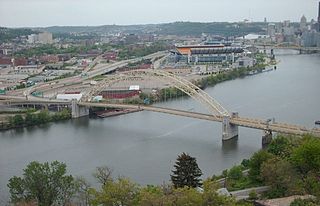
The West End Bridge is a steel tied-arch bridge over the Ohio River in Pittsburgh, Pennsylvania, approximately 1 mile (1.6 km) below the confluence of the Allegheny and Monongahela Rivers. It connects the West End to the Chateau neighborhood on the North Side of Pittsburgh.

The Rachel Carson Bridge, also known as the Ninth Street Bridge, spans the Allegheny River in Downtown Pittsburgh, Pennsylvania in the United States.
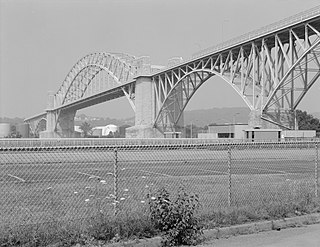
The McKees Rocks Bridge is a steel trussed through arch bridge which carries the Blue Belt, Pittsburgh's innermost beltline, across the Ohio River at Brighton Heights and McKees Rocks, Pennsylvania, connecting Pennsylvania Route 65 with Pennsylvania Route 51, west of the city.

Foxburg Bridge was a steel-built truss bridge in Foxburg, Pennsylvania. The crossing, which spanned the Allegheny River, was built by the Baltimore and Ohio Railroad in the 1920s. It originally had a two-tier design in which the top level carried a branch of Northern Subdivision railroad while the lower level was used by road traffic and pedestrians.

The 33rd Street Railroad Bridge is a truss bridge that carries the Allegheny Valley Railroad on the P&W Subdivision over the Allegheny River that connects downtown Pittsburgh, Pennsylvania to Herrs Island, Pittsburgh, United States.

The Jonathon Hulton Bridge, built in 1908, was the first major bridge designed by Allegheny County, Pennsylvania. Spanning the Allegheny River, it connected the eastern Pittsburgh suburbs of Oakmont and Harmarville, Pennsylvania.
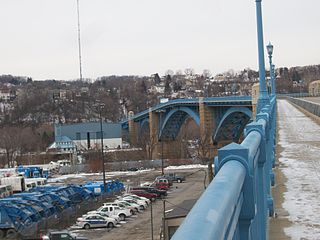
The William Raymond Prom Memorial Bridge, commonly known as the 31st Street Bridge, is an arch bridge that carries vehicular traffic across the Allegheny River between the Pittsburgh neighborhoods of Troy Hill and the Strip District. The bridge passes over but does not serve Washington's Landing, which is connected to the mainland by the 30th Street Bridge. Sidewalks along the bridge feature viewing platforms.
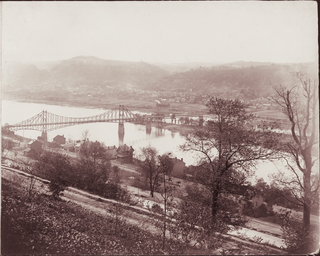
The 1902 Highland Park Bridge was a cantilever through truss suspension bridge that carried two streetcar tracks across the Allegheny River and Sixmile Island between the Pittsburgh neighborhood of Highland Park and Sharpsburg, Pennsylvania. By the 1930s, the bridge had become notorious for its narrowness and chronic maintenance problems, prompting suggestions for replacement. This bridge, known also as the Highland Park Bridge opened in 1938.

The PC&Y Railroad Bridge carries a single railroad track over the Ohio River, between Stowe Township, Pennsylvania and Neville Island, Pennsylvania.






















